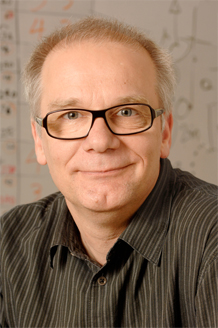NSF Award from the Division of Chemical, Bioengineering, Environmental, and Transport Systems
Freely-Falling Granular Powder Streams as Sensitive Probes of Interparticle Forces
- Principal Investigator: Heinrich Jaeger, PhD, Professor in Physics and the James Franck Institute, Director of the Materials Research Science and Engineering
- Start Date: July 15, 2009
- Total Award Amount: $306,675
Project Description
TECHNICAL SUMMARY
This project investigates a new class of free-standing, ultrathin sheets comprised of layers of close-packed metallic nanoparticles, each particle surrounded by a thin shell of short organic molecules that act as inter-particle spacers. The sheets can be self-assembled in a single processing step from solution onto a solid substrate, can drape themselves over open holes in the substrate that are hundreds to thousands of nanoparticles across, and exhibit remarkable mechanical strength and robustness, including Young’s moduli of several GigaPascal. As monolayers these sheets are the thinnest structures that can be fabricated from nanoparticle building blocks. The project exploits the fact that the properties of nanoparticle assemblies can be tuned by varying the size, shape and type of the individual particles and, independently, by varying the spacer molecules. Free-standing sheets make it possible to investigate the unique material properties of large assemblies of nanoscale building blocks without interference from a substrate, and at the same time allow for direct experimental access, via a range of probes such as transmission electron or scanning probe microscopies, to the individual building blocks themselves. Combining systematic experiments with simulations of the elastic response, the research addresses a key issue that is still unanswered, namely the detailed mechanisms giving rise to the observed large tensile strength of ultrathin nanoparticle sheets. In addition, new directions are pursued, such as the possibility of introducing mechanical anisotropy through suitable particle shapes, further tunability through the use of magnetic particles, and the feasibility of the sheets as novel resonators.
NON-TECHNICAL SUMMARY
Nanoparticle self-assembly offers special opportunities for the design of next-generation materials. This project focuses on a new class of ultra-thin sheets, fabricated from single layers of metal nanoparticles. In this ultrathin limit, the sheets combine extreme flexibility with unusual mechanical strength. This combination makes it possible to design novel coatings as well as freely suspended monolayer membranes involving 10 million or more particles. The project also provides a natural platform for integrating research with training and outreach. It will train one postdoc and one graduate student in vital nanoscience know-how, and introduce undergraduates to forefront science. A unique component is a set of outreach activities that include the development and prototyping of small-scale, hands-on activities with a major science museum.
This award is funded under the American Recovery and Reinvestment Act of 2009, NSF Award number: 0907075

Heinrich Jaeger, PhD,
Professor in Physics and the James Franck Institute, Director of the Materials Research Science and Engineering
